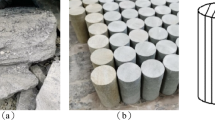Abstract
Access tunnel in the main powerhouse of Shuangjiangkou hydropower station was deep buried with high in situ stress and complex geological conditions. Microseismic monitoring technology was established to monitor microcrack evolution process inside the surrounding rock in early excavation stage. Serious falling blocks in the left spandrel of the tunnel were predicted in a timely manner by delimiting major damage areas in the tunnel. Based on comparative analysis on microseismic activity law and field failure characteristics of the access tunnel, a quantitative index was supposed between slight rockburst like falling blocks and microseismic events. Moreover, the change law of daily average apparent stress difference and b value were analyzed based on microseismic event data. In addition, a three-dimensional numerical simulation software (RFPA3D) was used to simulate the damage distribution around the tunnel, and a relationship between spatial position of tunnel damage and direction of the maximum principal stress was qualitatively analyzed. The study results showed that advance speed of the tunnel working face was an important factor affecting the state of stress redistribution in surrounding rock mass, and the change law of b values of microseismic events could be used to predict activity state inside the surrounding rock effectively, which reflected mechanical properties and stress state of surrounding rock. In particular, field falling blocks became more serious with increasing b value, and field surrounding rock was relatively stable with minor b value. A risk of surrounding rock instability was relatively high with small b values. It provided an efficient method of predicting and assessing slight rockburst like falling blocks. The study results can provide significant guidance for field construction and later construction planning.














Similar content being viewed by others
References
Cheng GW, Ma TH, Tang CA, Liu HY, Wang SJ (2017) A zoning model for coal mining-induced strata movement based on microseismic monitoring. Int J Rock Mech Min Sci 94:123–138
Dong JX, Xu GL, Li ZP, Song SW, Zhang SS, Xiao PX, Zhang FT, Shen YJ (2014) Classification of failure modes and controlling measures for surrounding rock of large-scale cavers with high geostress. Chin J Rock Mech Eng 33(11):2161–2170 (In Chinese)
Feng XT, Chen BR, Li SJ, Zhang CQ, Xiao YX, Feng GL, Zhou H, Qiu SL, Zhao ZN, Yu Y, Chen DF, Ming HJ (2012) Studies on the evolution process of rockbursts in deep tunnels. J Rock Mech Geotech Eng 4(4):289–295
Feng GL, Feng XT, Chen BR, Xiao YX, Zhao ZN (2019) Effects of structural planes on the microseismicity associated with rockburst development processes in deep tunnels of the Jinping-II hydropower station, China. Tunn Undergr Sp Tech 84:273–280
Gutenberg B, Richter CF (1944) Frequency of earthquakes in California. Bull Seismol Soc Am 34(4):185–188
He MC, Xie HP, Peng SP, Jiang YD (2005) Study on rock mechanics in deep mining engineering. Chin J Rock Mech Eng 24(16):2803–2813 (In Chinese)
Jiang FX (2002) Application of microseismic monitoring technology of strata fracturing in underground coal mine. Chin J Geotech Eng 24(2):147–149 (In Chinese)
Kaiser PK, Mccreath DR, Tannant DD (1996) Canadian rockburst support handbook. Laurentian University, Sudbury, Geomechanics Research Centre, p 303
Liu XZ, Tang CA, Li LC, Lv PF, Liu HY (2017) Microseismic monitoring and 3D finite element analysis of the right bank slope, Dagangshan hydropower station, during reservoir impounding. Rock Mech Rock Eng 50(7):1901–1917
Liu F, Tang CA, Ma TH, Tang LX (2019) Characterizing rockbursts along a structural plane in a tunnel of the Hanjiang-to-Weihe River diversion project by microseismic monitoring. Rock Mech Rock Eng 52(6):1835–1856
Legge NB, Spottiswoode SM (1987) Fracturing and microseismicity ahead of a deep gold mine stope in the pre-remnant stages of mining/proceedings of the 6th international congress on rock mechanics. Montreal: [s.n.], p 1071-1078
Tang ZL, Liu XL, Li CY, Qin PX, Xu QJ (2018) Microseismic characteristic analysis in deep TBM construction tunnels. J Tsinghua Univ: Sci & Tech 58(5):461–468 (In Chinese)
Wyss M, Brune JN (2012) Seismic moment, stress, and source dimensions for earthquakes in the California-Nevada region. J Geophys Res 73(14):4681–4694
Wang HL, Ge MC (2008) Acoustic emission/microseismic source location analysis for a limestone mine exhibiting high horizontal stresses. Int J Rock Mech Min Sci 45(5):720–728
Xu NW, Dai F, Liang ZZ, Zhou Z, Sha C, Tang CA (2014) The dynamic evaluation of rock slope stability considering the effects of microseismic damage. Rock Mech Rock Eng 47(2):621–642
Xiao YX, Feng XT, Li SJ, Feng GL, Yu Y (2016) Rock mass failure mechanisms during the evolution process of rockbursts in tunnels. Int J Rock Mech Min Sci 100(83):174–181
Zhang BH, Deng JH, Gao MZ, Zhou ZH, Wu JC, Wu SH (2012) Safety evaluation research based on microseismic monitoring in underground powerhouse of hydropower station. Chin J Rock Mech Eng 31(5):937–944 (In Chinese)
Zhou XP, Peng SL, Zhang JZ, Qian QH, Lu RC (2018) Predictive acoustical behavior of rockburst phenomena in Gaoligongshan tunnel, Dulong river highway, China. Eng Geol 247:117–128
Funding
This work was supported by the National Natural Science Foundation of China (No. 51779031, 41977219) and the Open Fund of State Key Laboratory of Coal Resources and Safe Mining of China (No. SKLCRSMI9KFA02) for which the authors are very grateful.
Author information
Authors and Affiliations
Corresponding author
Rights and permissions
About this article
Cite this article
Liang, Z., Xue, R., Xu, N. et al. Analysis on microseismic characteristics and stability of the access tunnel in the main powerhouse, Shuangjiangkou hydropower station, under high in situ stress. Bull Eng Geol Environ 79, 3231–3244 (2020). https://doi.org/10.1007/s10064-020-01738-6
Received:
Accepted:
Published:
Issue Date:
DOI: https://doi.org/10.1007/s10064-020-01738-6




